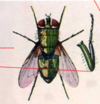Diptera - Cyclorrhapha - Calliphoridae Flashcards
Type of parasite
Facultative
Feed on? Breed in?
decaying organic matter and bector
Major diseases
Blow fly strike of sheep (cutaneous myiasis) Screw worm fly (exotic)
What is this?

Lucilia cuprina - green blow fly
What is this?

Chrysomya rufifacies - the hairy maggot blowfly:
dark bands on abdomen
What is this?

Calliphora stygia
speckled brown abdomen
What is this?

Sarcophaga sp
flesh fly
3 stripes on thorax
What is this?

Chrysomya varipes: small fly with banded legs
What is this?

Calliphora augur
brown with blue streak on abdomen
What is this?

Chrysomya sp
a blue/green species
Primary blowfly strike species
Green
Lucilia cuprina-introduced (90% of strikes)
Lucilia sericata-introduced - urban areas
Secondary blowfly strike species
Green:
Chrysoma rufifacies - native (sometimes primary)
Chrysoma varipes - native
Brown:
Calliphora stygia - native (sometimes primary)
Calliphora augurnative - native (sometimes primary)
Tertiary blowfly strike species
Black - Ophyra spp. native
Blue - Calliphora vicina - introduced (urban areas)
Flesh flies - Sacrophaga spp. native
Distribution of Lucilia cuprina vs sericata

Lucilia cuprina egg laying
eggs laid in fleece
laid in the afternoon/night
Lucilia cuprina lifecycle effect on host
Olfactory stimulus attracks flies (dags, urine, bacteria) as proteinaceous exudate on skin is needed for 1st instar.
Lasts 17 days in summer
1st instar need protein meal (can’t penetrate skin)
2nd instar penetrates skin (feeds on tissues)
3rd instar matures by 2-19 days
drops to soil at night -> burrows and pupates
overwinter as pupa
emerging female needs protein meal from anywhere
mate once
Consequences of lucilia cuprina
most strikes are covert and will heal
however secondary flies can invade and extend wound
Clinical signs of fly strike
Day 1-2: Sheep irritated
Day 3: Temperature rises
Day 4 maggots drop, smell!
Day 6: Temperature falls
Healing slow but complete
Can have 30% morality in a bad year
Facts about breech strike
Commonest form
soiling of fleece by urine or faeces
scouring due to nematodes
wrinkles predispose animal
Body strike facts
Preceded by fleece rot or dermatitis
prolonged wetting of skin -> ketatin lifts -> protein exudates
Pseudomonas spp proliferate and prove olfactory stimulus
Sway back and wrinckles predispose
Wax Content important
Fly strike seasonal facts
flies overwinter as pupae
flies emerge in sprin
3 generations in spring
summer too dry for eggs and first instars
2 generations in autumn
Fly Strike Control
- Make sheep less susceptile
- crutching
- tail docking
- removal of conformational faults
- breed for sheep with suitable fleece characteristics
- Mulesing (most successful method) - Reduce fly numbers
- treat all strikes early in the season
- burn or deeply bury carrion
- fly traps (drums with meat laced with insectocide)
- Genetic manipulation (sterile male, olfactory method)
- vaccine (under investigation)
- Chemicals - organophosphates (resistance) growth regulators (cyromazine, vetrazin)
Scientific name for the maggot blowfly
Chrysomya rufifacies
(larvae feed on other maggots)



